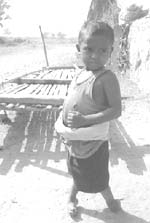A deformed existence
 GANDHAR KARMAKAR is nine years old. He has only one eye, and suffers from paralysis. Elder to him by three years is Motiram. He suffers from osteoporosis (general bone damage). Dunia Uraon, also just short of his teens, is another unfortunate adolescent. His mother suffered three miscarriages before giving birth to him and his sister, both physically handicapped. All of them are residents of Mechua village near Jaduguda, a small tribal-dominated region in south Bihar. The village is hardly a kilometre from the Uranium Corporation India Limited (ucil), which is involved in uranium extraction and is the sole supplier of the metal for India's nuclear power plants. Deformities among children in Jaduguda are a norm rather than an exception.
GANDHAR KARMAKAR is nine years old. He has only one eye, and suffers from paralysis. Elder to him by three years is Motiram. He suffers from osteoporosis (general bone damage). Dunia Uraon, also just short of his teens, is another unfortunate adolescent. His mother suffered three miscarriages before giving birth to him and his sister, both physically handicapped. All of them are residents of Mechua village near Jaduguda, a small tribal-dominated region in south Bihar. The village is hardly a kilometre from the Uranium Corporation India Limited (ucil), which is involved in uranium extraction and is the sole supplier of the metal for India's nuclear power plants. Deformities among children in Jaduguda are a norm rather than an exception.
The story of Jaduguda is very similar to the one in Rawatbhata, a village on the eastern bank of the Rana Pratap Sagar lake, about 50 km from Kota, Rajasthan. In 1990, a scientist couple, Surendra and Sangamitra Gadekar, came across a deformed child in their alternative education centre at Vedchi near Surat, Gujarat. The child's parents told them that a neighbour in their hometown Rawatbhata also had a child with a similar deformity. In fact, there were many more. Upon investigation, the Gadekars found that there was an "extraordinary rise in congenital deformities' in the village since the Rajasthan Atomic Power Plant (raps) came up in 1972.
The similarity between Jaduguda and Rawatbhata does not end with the number of children born with deformities. They are also home to companies that work with hazardous substances, and it is stated that they do not dispose of their wastes in the approved manner. The local people say ucil
